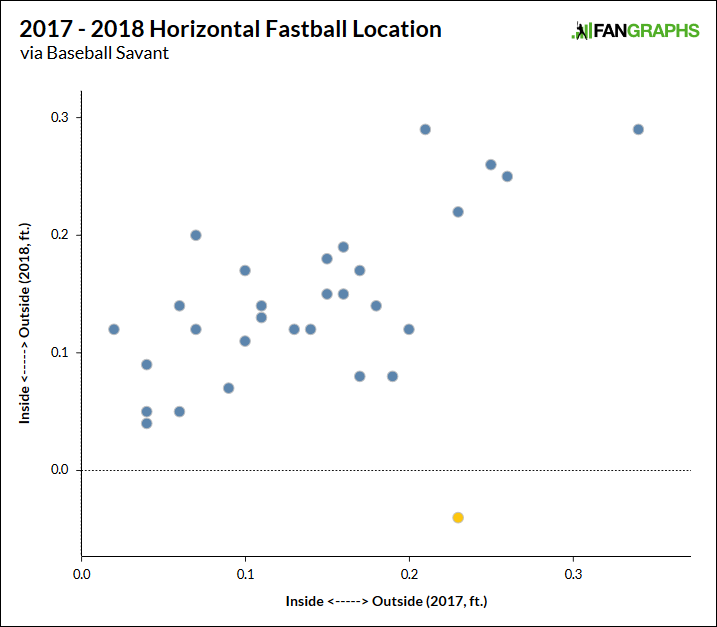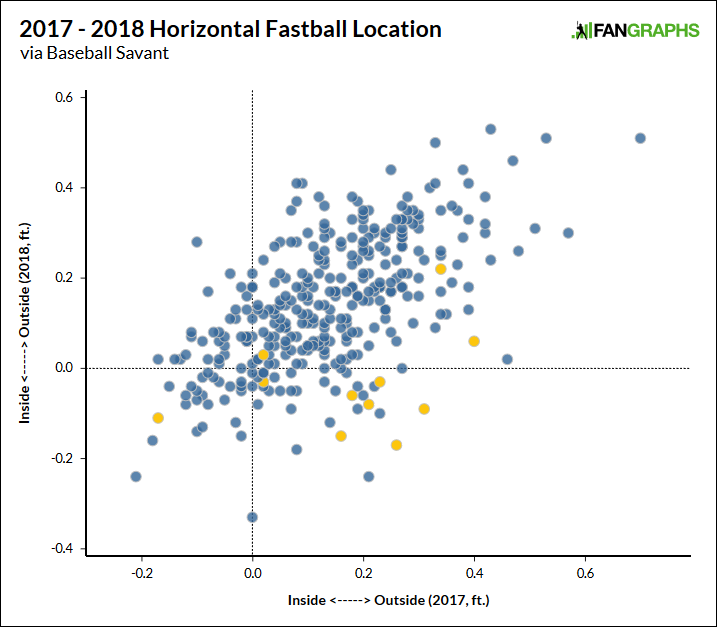Mets Pitchers Adopted a Whole New Identity
With spring training just around the corner, I should remind you that you should feel safe ignoring just about everything anyone says. There’s so much noise, and so little signal. It makes sense that it would be that way, to be sure — it’s an optimistic time of year — but optimism has a tenuous relationship with the reality of the future. Every clubhouse has a great group of guys. Every team is talented enough to surprise some people. Every injury is buried in the past. Every new pitch is going to miss bats.
People say optimistic things about themselves, and coaches say optimistic things about strategy implementation. Here’s how these players are going to platoon. Here’s how the bullpen is going to shake out. Here’s how the team will fold in more shifts. How many times have we heard coaches say their clubs are going to run more often? The clubs typically don’t run more often. It’s just a thing to say when it’s still theoretical. When the games start to count, only then can you test one’s commitment to an idea.
With all of this in mind, I’d like to bring your attention to the 2018 Mets. The 2018 Mets operated under a new pitching coach, in Dave Eiland. Like many other coaches, Eiland voiced some ideas in spring training. But out of that fog, the Mets did something concrete. As is common, there was an idea. As is uncommon, there was subsequent follow-through.
Here’s the headline of a Kristie Ackert column from last March:
Dave Eiland wants Mets pitchers to be the most aggressive in baseball
Within, Eiland tells the anecdote of Noah Syndergaard buzzing Alcides Escobar in the World Series. While the rest of the Royals lost their minds, Eiland couldn’t help but smile, recognizing that Syndergaard instantly made the hitters uncomfortable. As Eiland continued, he wanted to see the Mets pitch more often over the inner half:
Eiland firmly believes there have been changes made to the baseball itself and that hitters are improving their approaches, so pitchers have to get back to pitching. That means Eiland wants Syndergaard and the rest of the Mets pitchers going inside, moving hitters off the plate and basically making them uncomfortable, since so many hitters have taken to leaning over the plate and cheating on pitches.
“It is something we are going to stress,” said manager Mickey Callaway, who believed in the same philosophy when he was Cleveland’s pitching coach.
The idea was nothing revolutionary. “Establish the inner half” is as much a pitching bromide as “establish the fastball.” Nevertheless, sometimes old ideas can be good ideas. And what’s most significant is how the Mets dramatically adjusted.
In 2017, the Mets’ average fastball was located 0.23 feet outside, away from the horizontal middle of the strike zone. That was the fifth-most outside average location in baseball. Put another way, the Mets threw 38.1% of their fastballs over the inner half. That was baseball’s fifth-lowest rate.
In 2018, the Mets’ average fastball was located 0.04 feet inside, away from the horizontal middle of the strike zone. That was the most inside average location in baseball. Put another way, the Mets threw 51.3% of their fastballs over the inner half. That was baseball’s highest rate.
By both metrics, the Mets went from 26th to 1st. It’s striking when you look at it visually. Here’s a plot for every team in 2017 and 2018. You’re seeing average horizontal fastball locations, and the Mets are the point in yellow.
Here are the ten teams whose fastballs shifted the most inside, on average:
| Team | 2017 X | 2018 X | Change |
|---|---|---|---|
| NYM | 0.23 | -0.04 | -0.27 |
| STL | 0.19 | 0.08 | -0.11 |
| OAK | 0.17 | 0.08 | -0.10 |
| CHC | 0.20 | 0.12 | -0.08 |
| LAA | 0.34 | 0.29 | -0.05 |
| TOR | 0.18 | 0.14 | -0.04 |
| KC | 0.14 | 0.12 | -0.02 |
| PIT | 0.09 | 0.07 | -0.02 |
| SF | 0.06 | 0.05 | -0.02 |
| BOS | 0.13 | 0.12 | -0.02 |
Compared to 2017, the 2018 Mets threw their average fastball more inside by 3.2 inches. The Cardinals, in second place, moved inside by an average of just 1.4 inches. It’s no different by the other measure — the Mets’ inner-half fastball rate increased by a league-high 13.2 percentage points. The Cardinals came in second, with an increase of 6.4 percentage points. As team-wide strategic shifts go, the Mets did something exceptional, and, of course, that which takes place at the team level must also happen at the player level.
Here’s another plot of 2017 and 2018 average horizontal fastball locations. But where the previous plot was for teams, this one is showing individual pitchers, and the 2018 Mets pitchers are highlighted in yellow.
This data sample has 335 qualifying pitchers. Here are the ten pitchers whose average fastballs shifted the most inside:
| Pitcher | 2017 X | 2018 X | Change |
|---|---|---|---|
| Liam Hendriks | 0.21 | -0.24 | -0.45 |
| Adam Morgan | 0.46 | 0.02 | -0.43 |
| Zack Wheeler | 0.26 | -0.17 | -0.43 |
| Seth Lugo | 0.31 | -0.09 | -0.40 |
| Jacob deGrom | 0.40 | 0.06 | -0.34 |
| Luis Avilan | 0.00 | -0.33 | -0.33 |
| John Axford | 0.23 | -0.10 | -0.32 |
| Robert Gsellman | 0.16 | -0.15 | -0.31 |
| Steven Matz | 0.21 | -0.08 | -0.29 |
| Kyle Freeland | 0.19 | -0.09 | -0.28 |
Ten pitchers, with five of them Mets. The Mets also had the guy in 16th place, as well as the guy in 20th place. I wouldn’t have even thought about this had I not been looking up Zack Wheeler on Tuesday night. I noticed he’d done something with his fastballs, and then I came to realize it was a team-wide adjustment. The Mets did what they said they were going to do. Far more often, the Mets went on the attack. It’s tough to argue with the results.
In 2017, the Mets’ pitching staff wound up with a 9.1 WAR, ranking 25th. In 2018, they wound up with a 16.9 WAR, ranking 8th. It’s not totally fair to just show that year-to-year comparison, because there were health and personnel changes. Syndergaard, for example, barely pitched in 2017, and he’s terrific. But how about we consider the following table? Just above, I showed that the Mets had five of the ten biggest inside-fastball shifts. Here’s how those five pitchers did in 2017 and 2018, according to Statcast’s expected wOBA metric:
| Pitcher | 2017 xwOBA | 2018 xwOBA | Change |
|---|---|---|---|
| Zack Wheeler | 0.342 | 0.277 | -0.065 |
| Seth Lugo | 0.331 | 0.270 | -0.061 |
| Steven Matz | 0.353 | 0.303 | -0.050 |
| Robert Gsellman | 0.334 | 0.288 | -0.046 |
| Jacob deGrom | 0.276 | 0.243 | -0.033 |
Across-the-board improvement. Of course, we can’t just point to one single reason. Lugo and Gsellman, for example, moved to the bullpen. But there’s at least some reason to believe the Mets were better off for implementing Eiland’s strategy. They definitely went inside with their fastballs far more often, and their results were all better. Years ago, the Pirates drew attention for their own inside-fastball tactics, but the game has changed since then. Hitters are trying to do different things. The Mets have their own reasons for going in, and it certainly seemed to help the bulk of their staff.
It should be understood that there’s no one way to pitch. The Mets just threw the most inside average fastball. The Indians just threw the seventh-most outside average fastball. The Diamondbacks, who had a good staff, liked to stay away. The White Sox, who had a bad staff, liked to work inside. It’s not like the Mets stumbled upon the only way to succeed. Everybody has different ideas. It almost always comes down to execution and health.
But for Eiland and the Mets, they had an idea. It was an idea that required buy-in from just about every last pitcher. And over the course of six months, they pulled it off, making one of the more dramatic team-wide adjustments you’re likely to see. The Mets became baseball’s most aggressive pitching staff. I don’t know why we wouldn’t see that continue.
Jeff made Lookout Landing a thing, but he does not still write there about the Mariners. He does write here, sometimes about the Mariners, but usually not.


It certainly doesn’t hurt to throw inside when 4/5th of your starting rotation throws 95+. If ever the old adage of “hard stuff in / soft stuff away” would be true, it’s with these Mets.
Interesting you say that because I felt like I noticed the most pronounced change watching Matz, the <95 portion of the rotation — and particularly the mistakes, when you could see he was aiming inside but then the ball would tail back over the middle of the plate. It still probably helped him on average but the strategy of establishing inside works a lot better when you have enough velocity, or natural movement, that the mistakes don't end up as meatballs.